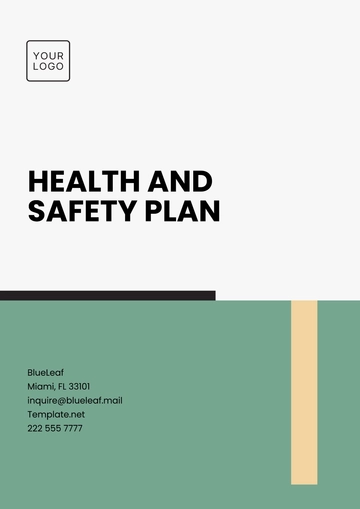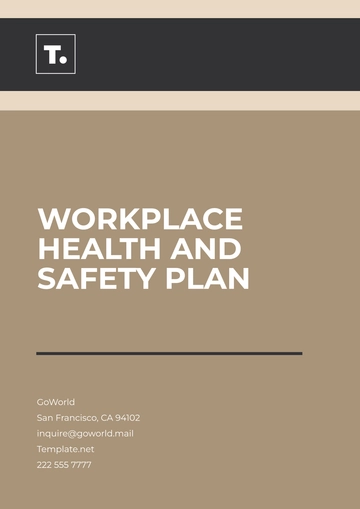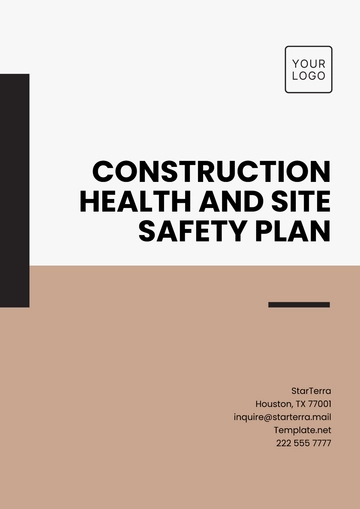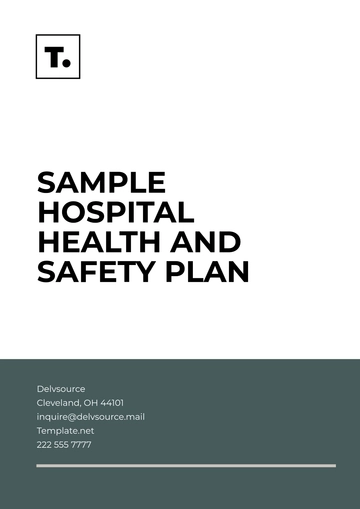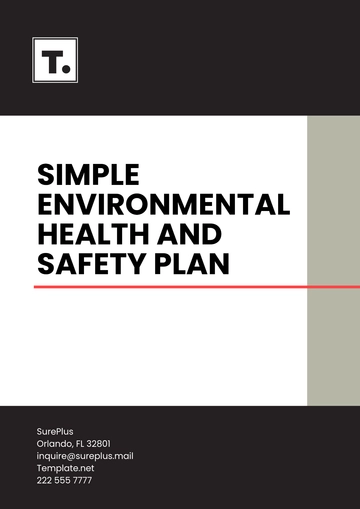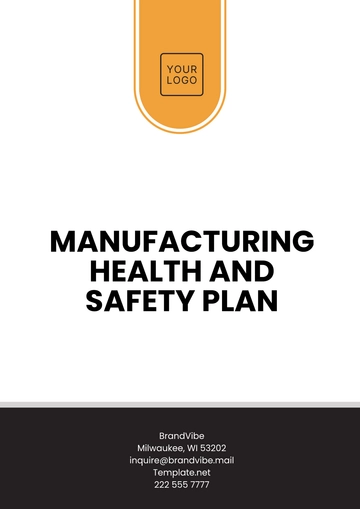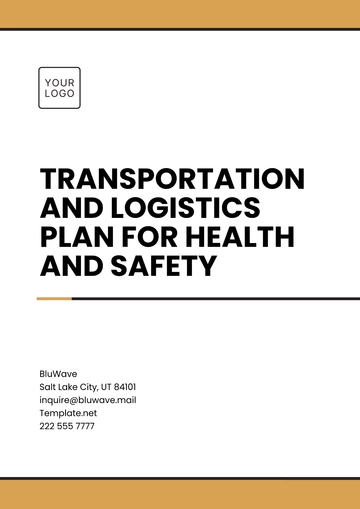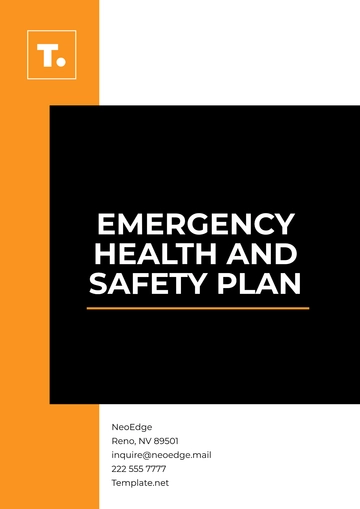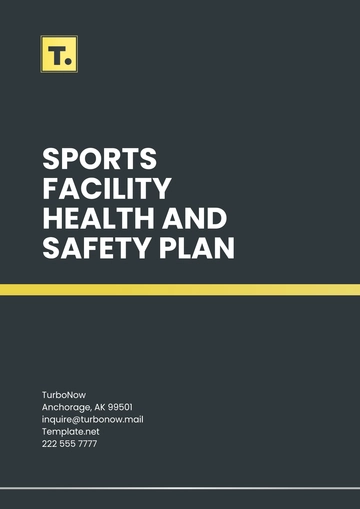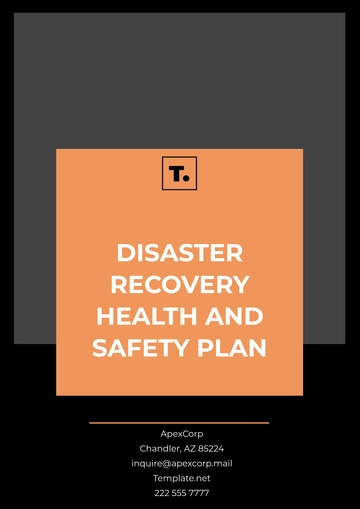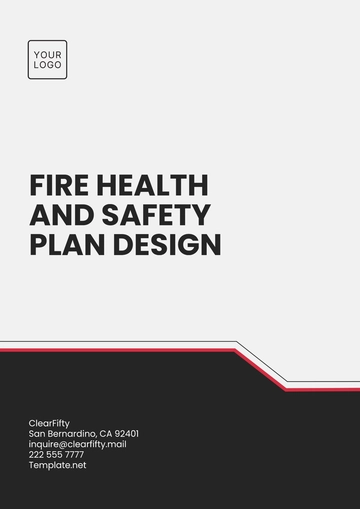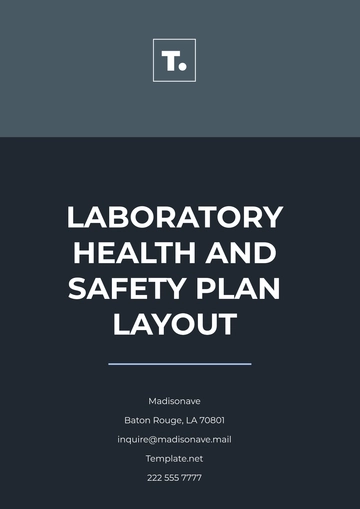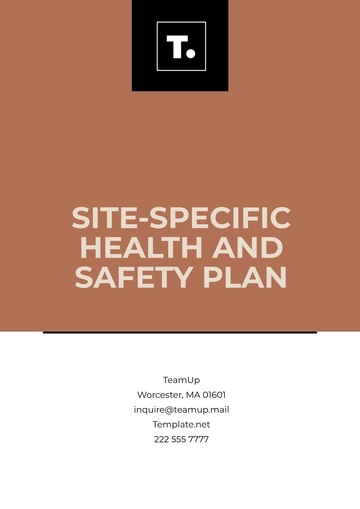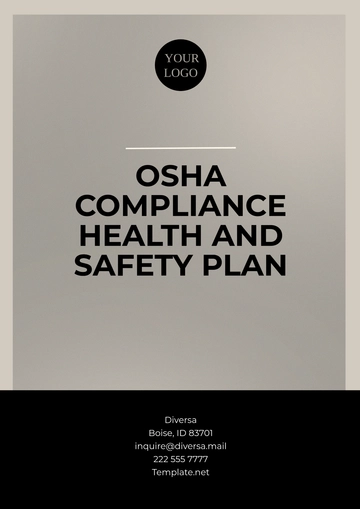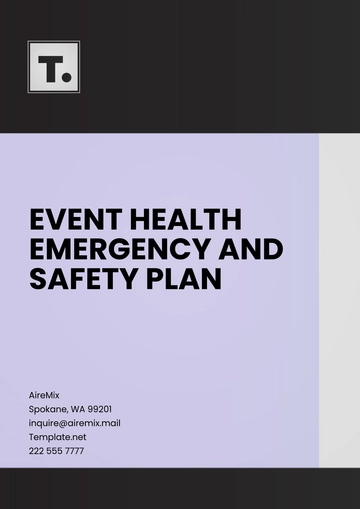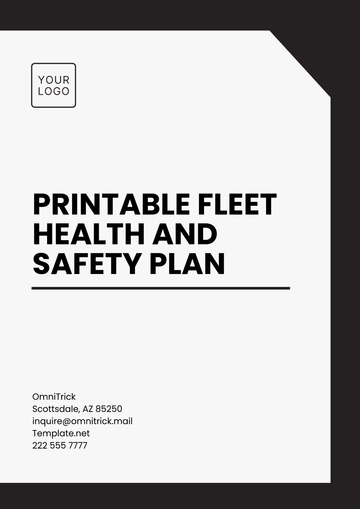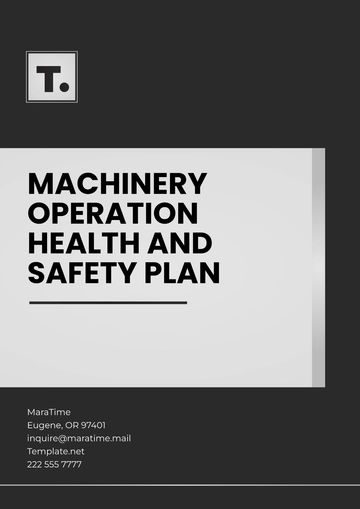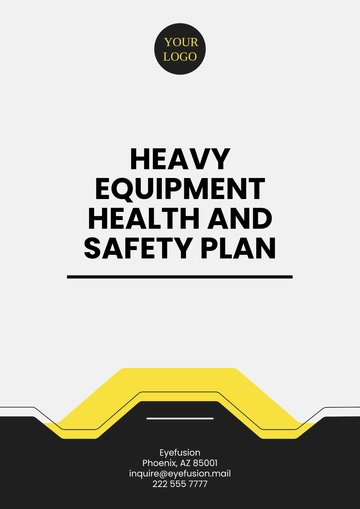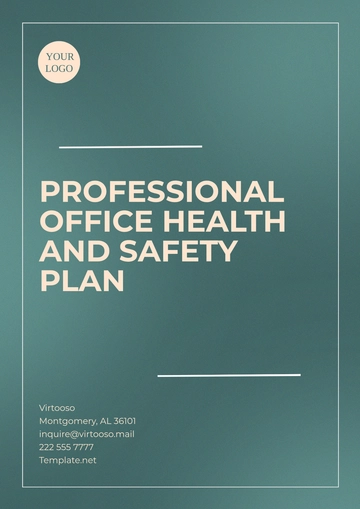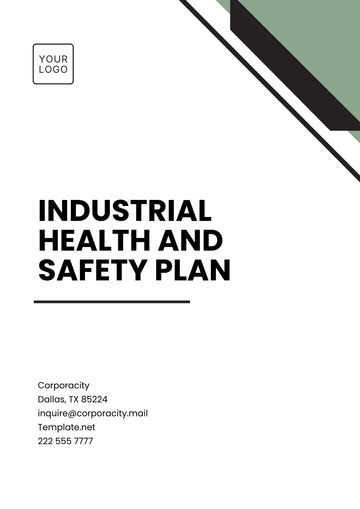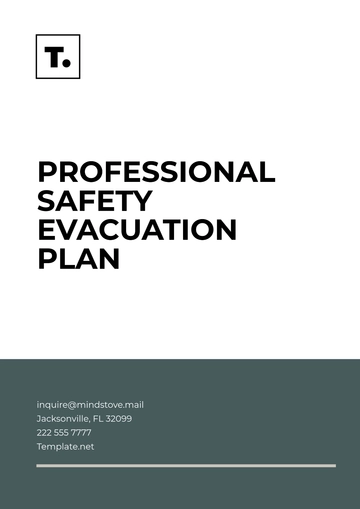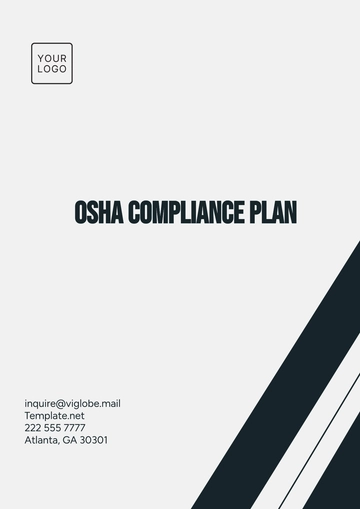Free Gym Safety Plan
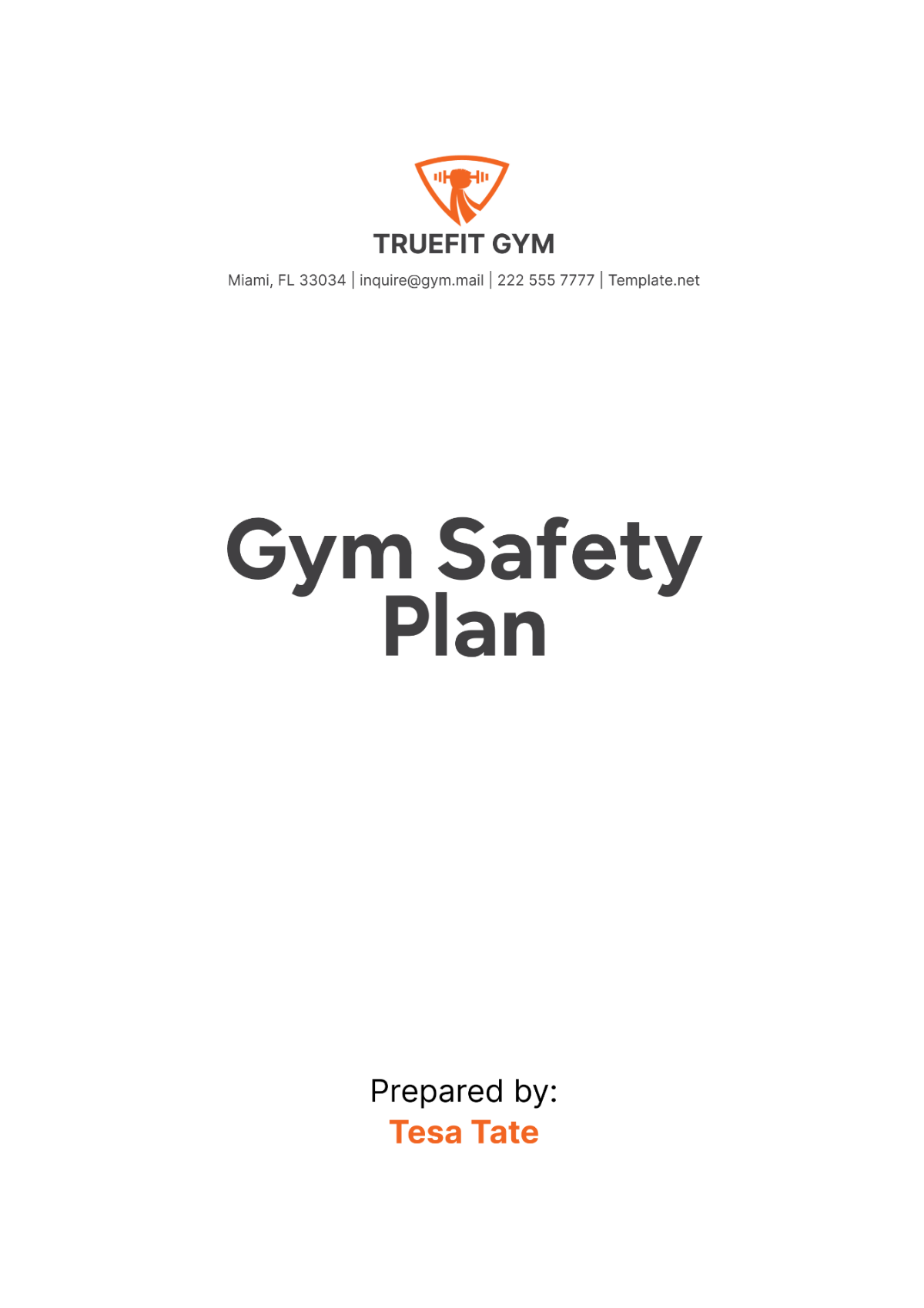
I. Executive Summary
This Safety Plan for [Your Company Name] is designed to ensure the safety and well-being of all members, staff, and visitors. This plan outlines the necessary protocols and procedures to maintain a safe and secure environment within the gym premises. Adherence to these safety standards is crucial for preventing accidents, managing risks, and providing a safe fitness environment.
This safety plan addresses various aspects, including emergency preparedness, equipment safety, hygiene protocols, staff training, and member education. By implementing these measures, [Your Company Name] aims to foster a culture of safety and responsibility among all stakeholders. The goal is to mitigate potential hazards and ensure compliance with local regulations and industry best practices.
This plan details the specific strategies and actions required to uphold the highest safety standards. It includes a thorough analysis, actionable steps, and insights to guide the implementation of the safety protocols. By following this plan, [Your Company Name] will create a safer environment that enhances the overall gym experience for everyone.
II. Emergency Preparedness
A. Emergency Response Plan
Emergency Contacts: Maintain an updated list of emergency contacts, including local fire department, police, and medical services. This ensures quick access to essential services during emergencies.
Evacuation Routes: Clearly mark and communicate evacuation routes throughout the gym. Regular drills should be conducted to familiarize staff and members with the evacuation procedures.
First Aid Kits: Ensure that first aid kits are readily available and fully stocked at multiple locations within the gym. Staff should be trained to use these kits effectively.
Emergency Drills: Conduct regular emergency drills, including fire and evacuation drills, to ensure preparedness. Drills help in identifying potential issues and improving response times.
Crisis Communication: Develop a crisis communication plan to provide timely information to members, staff, and emergency responders. Effective communication minimizes panic and ensures coordinated responses.
B. Fire Safety
Fire Extinguishers: Place fire extinguishers at strategic locations and ensure they are regularly inspected. Staff should be trained in their proper use.
Smoke Detectors: Install and maintain smoke detectors in all areas of the gym. Regular testing and maintenance ensure they are functional.
Fire Exits: Clearly mark and ensure accessibility of all fire exits. Fire exits should be free from obstructions and easily accessible during emergencies.
Fire Safety Training: Provide fire safety training for all staff members, including the use of fire extinguishers and evacuation procedures. Regular training sessions reinforce knowledge and preparedness.
III. Equipment Safety
A. Maintenance and Inspection
The following table outlines the maintenance and inspection schedule for gym equipment:
No. | Equipment Type | Maintenance Frequency | Inspection Frequency |
|---|---|---|---|
1 | Treadmills | Monthly | Weekly |
2 | Weight Machines | Bi-Monthly | Weekly |
3 | Free Weights | Quarterly | Bi-Weekly |
4 | Exercise Bikes | Monthly | Weekly |
5 | Resistance Bands | Quarterly | Monthly |
Treadmills: Treadmills require monthly maintenance and weekly inspections to ensure they are in proper working condition. Regular maintenance prevents breakdowns and ensures member safety.
Weight Machines: Weight machines should undergo bi-monthly maintenance and weekly inspections. This schedule helps in identifying wear and tear early, preventing potential injuries.
Free Weights: Free weights need quarterly maintenance and bi-weekly inspections. Ensuring the integrity of free weights prevents accidents caused by damaged or faulty equipment.
Exercise Bikes: Monthly maintenance and weekly inspections of exercise bikes ensure they are safe and functional. Regular checks help in maintaining their performance and member safety.
Resistance Bands: Resistance bands should be inspected monthly and maintained quarterly. Regular checks prevent accidents caused by wear and tear of these frequently used items.
B. Usage Guidelines
Instructional Signage: Place instructional signage near all equipment to guide members on proper usage. Clear instructions help prevent misuse and potential injuries.
Orientation Sessions: Offer orientation sessions for new members to familiarize them with the equipment. Proper orientation reduces the risk of accidents and promotes safe usage.
Supervised Training: Provide supervised training sessions to ensure members use equipment correctly. Supervision by trained staff enhances safety and effectiveness of workouts.
Report Mechanism: Implement a mechanism for members to report faulty equipment. Prompt reporting and addressing of issues ensure continuous safety and functionality.
Regular Audits: Conduct regular audits to ensure compliance with equipment safety guidelines. Audits help in identifying areas for improvement and maintaining high safety standards.
IV. Hygiene Protocols
A. Cleaning and Disinfection
The following table outlines the cleaning and disinfection schedule for different areas of the gym:
No. | Area | Cleaning Frequency | Disinfection Frequency |
|---|---|---|---|
1 | Workout Area | Daily | Twice Daily |
2 | Locker Rooms | Daily | Daily |
3 | Restrooms | Twice Daily | Twice Daily |
4 | Reception Area | Daily | Daily |
5 | Equipment | After Each Use | Daily |
Workout Area: The workout area must be cleaned daily and disinfected twice daily to maintain a hygienic environment. Regular cleaning prevents the spread of germs and ensures a pleasant workout experience.
Locker Rooms: Locker rooms need to be cleaned and disinfected daily to ensure cleanliness and hygiene. Maintaining locker rooms prevents the build-up of bacteria and unpleasant odors.
Restrooms: Restrooms must be cleaned and disinfected twice daily to maintain high hygiene standards. Frequent cleaning ensures a safe and sanitary environment for members.
Reception Area: The reception area needs to be cleaned and disinfected daily to ensure a welcoming and clean environment. A clean reception area creates a positive first impression for members and visitors.
Equipment: Gym equipment must be cleaned after each use and disinfected daily. Regular cleaning of equipment prevents the spread of germs and ensures a safe workout environment.
B. Personal Hygiene
Hand Sanitizers: Provide hand sanitizers at multiple locations throughout the gym. Encouraging members to use hand sanitizers helps in maintaining personal hygiene and preventing the spread of germs.
Wipe Stations: Place wipe stations near equipment for members to clean equipment after use. Wipe stations promote cleanliness and responsibility among members.
Hygiene Posters: Display hygiene posters to remind members of personal hygiene practices. Visual reminders reinforce the importance of hygiene in maintaining a safe environment.
Shower Facilities: Ensure shower facilities are clean and well-maintained for members. Clean shower facilities promote personal hygiene and member satisfaction.
Towel Service: Offer towel service for members to use during workouts. Providing clean towels enhances hygiene and member comfort.
V. Staff Training
A. Safety Training Programs
Regular Workshops: Conduct regular safety workshops to keep staff updated on safety protocols. Continuous learning ensures staff are well-prepared to handle safety issues.
Emergency Procedures: Train staff on emergency procedures, including evacuation and first aid. Proper training ensures quick and effective response during emergencies.
Equipment Handling: Provide training on proper equipment handling and maintenance. Knowledgeable staff can ensure equipment safety and prevent accidents.
Hygiene Practices: Educate staff on hygiene practices and cleaning protocols. Staff adherence to hygiene practices maintains a clean and safe gym environment.
B. Certification Requirements
CPR Certification: Require staff to obtain CPR certification to handle medical emergencies. Certified staff can provide immediate assistance, potentially saving lives.
First Aid Training: Ensure all staff are trained in basic first aid. First aid training equips staff to handle minor injuries and provide initial care.
Fire Safety Certification: Staff should obtain fire safety certification to ensure they are prepared for fire emergencies. Certified staff can respond effectively and ensure member safety.
Ongoing Education: Encourage staff to participate in ongoing education and training programs. Continuous learning enhances staff skills and knowledge, contributing to overall safety.
VI. Member Education
A. Safety Orientation
New Member Orientation: Provide a comprehensive safety orientation for new members. Orientations ensure members are aware of safety protocols and gym rules.
Safety Videos: Utilize safety videos to educate members on proper gym usage and safety practices. Visual aids enhance understanding and retention of safety information.
Workshops and Seminars: Offer workshops and seminars on various safety topics. Educational events provide in-depth knowledge and promote a safety culture among members.
B. Communication Channels
Bulletin Boards: Use bulletin boards to communicate safety information and updates. Visible information keeps members informed and aware of safety protocols.
Newsletters: Send regular newsletters with safety tips and updates. Newsletters reinforce safety messages and keep members engaged.
Mobile App Notifications: Utilize the gym’s mobile app to send safety notifications and reminders. Instant communication through the app ensures members receive timely updates.
VII. Risk Management
A. Risk Assessment
The following table outlines potential risks and their mitigation strategies:
No. | Risk | Likelihood | Impact | Mitigation Strategy |
|---|---|---|---|---|
1 | Equipment Failure | Medium | High | Regular Maintenance |
2 | Member Injury | Medium | High | Staff Training and Supervision |
3 | Fire | Low | Very High | Fire Safety Measures |
4 | Hygiene Issues | Medium | Medium | Strict Cleaning Protocols |
5 | Theft | Low | Medium | Security Measures |
Equipment Failure: Equipment failure is a medium likelihood risk with high impact. Regular maintenance and inspections are crucial to prevent failures and ensure member safety.
Member Injury: Member injury has a medium likelihood and high impact. Proper staff training and supervision are essential to minimize the risk of injuries and provide immediate assistance when needed.
Fire: Fire is a low likelihood but very high impact risk. Implementing fire safety measures, such as installing smoke detectors and conducting regular fire drills, is vital for preventing and responding to fire emergencies.
Hygiene Issues: Hygiene issues have a medium likelihood and medium impact. Strict cleaning protocols and promoting personal hygiene practices among members can mitigate these risks and ensure a clean environment.
Theft: Theft is a low likelihood risk with a medium impact. Implementing security measures, such as surveillance cameras and secure lockers, helps in preventing theft and ensuring member safety.
B. Insurance Coverage
Liability Insurance: Ensure comprehensive liability insurance to cover potential risks. Liability insurance protects the gym against legal and financial repercussions of accidents and injuries.
Property Insurance: Obtain property insurance to cover damage to gym facilities and equipment. Property insurance provides financial protection and supports quick recovery in case of damage.
Health Insurance: Offer health insurance for staff to cover medical expenses in case of work-related injuries. Health insurance ensures staff well-being and financial security.
Member Insurance: Provide optional insurance coverage for members to cover potential injuries. Offering insurance options enhances member confidence and trust in the gym's safety measures.
VIII. Monitoring and Evaluation
A. Safety Audits
It is important to conduct regular safety audits in order to comprehensively assess the compliance of an organization with established safety protocols. These audits play a crucial role in identifying any existing gaps or deficiencies in the safety measures currently in place. Furthermore, they help ensure that there is a continuous and ongoing process of improvement, thereby enhancing the overall safety standards within the organization.
B. Hygiene Inspections
Conduct thorough hygiene inspections to guarantee that cleanliness is maintained and that all established cleaning protocols are strictly followed. Performing these inspections on a regular basis is essential for upholding high standards of hygiene.
C. Equipment Checks
To maintain both the functionality and safety of gym equipment, it is essential to implement consistently scheduled inspections and testing procedures. By conducting these regular checks, one can effectively prevent accidents that might otherwise occur due to equipment malfunctions or failures. Additionally, these routine inspections contribute to the longevity of the gym equipment, ensuring that it remains in good working condition and extends its usable lifespan.
D. Feedback Mechanism
Develop and implement a comprehensive feedback mechanism that allows both staff and members to report any safety concerns they may have. By actively encouraging the provision of feedback from all parties, continuous monitoring and subsequent improvement of safety measures can be ensured. This approach fosters an environment where safety standards are constantly evaluated and upgraded based on the input from those directly involved or affected by these measures.
IX. Conclusion and Next Steps
A. Conclusion
The Safety Plan for [Your Company Name] outlines a detailed strategy to ensure the safety and well-being of all members, staff, and visitors. By implementing rigorous safety protocols, conducting regular training, and promoting a culture of safety, the gym can maintain a secure and healthy environment. Continuous evaluation and improvement of safety measures will support the gym’s commitment to excellence and member satisfaction.
Ensuring safety standards is essential for the gym’s success and reputation. By addressing potential risks, ensuring emergency preparedness, and fostering a proactive approach to safety, [Your Company Name] can provide a safe and enjoyable fitness experience for all. This comprehensive safety plan serves as a foundation for achieving these goals and ensuring the long-term success of the gym.
B. Next Steps
The next steps to ensure the effective implementation of the Safety Plan are as follows:
Implement Training Programs: Carry out comprehensive and regularly scheduled safety training programs designed specifically for both staff and members.
Conduct Safety Audits: Plan, organize, and execute preliminary safety assessments in order to identify and rectify any deficiencies that may exist.
Upgrade Equipment: Evaluate the current state of the gym equipment and make any necessary updates or replacements to ensure that all equipment meets established safety standards.
Promote Hygiene Practices: Ensure adherence to hygiene protocols by reinforcing them consistently, and supply all the necessary materials and equipment required to maintain an optimal level of cleanliness.
Engage Members: Encourage the active participation of team members in safety initiatives by organizing and conducting a series of workshops and holding feedback sessions.
By following these steps, [Your Company Name] can ensure the successful implementation and ongoing effectiveness of the plan.
- 100% Customizable, free editor
- Access 1 Million+ Templates, photo’s & graphics
- Download or share as a template
- Click and replace photos, graphics, text, backgrounds
- Resize, crop, AI write & more
- Access advanced editor
Develop a robust safety strategy with the Gym Safety Plan Template! This template on Template.net offers a customizable framework for creating a comprehensive safety plan. Its editable design allows for easy modifications to address specific safety concerns. The integrated AI Editor helps in ensuring your gym adheres to safety standards!
You may also like
- Finance Plan
- Construction Plan
- Sales Plan
- Development Plan
- Career Plan
- Budget Plan
- HR Plan
- Education Plan
- Transition Plan
- Work Plan
- Training Plan
- Communication Plan
- Operation Plan
- Health And Safety Plan
- Strategy Plan
- Professional Development Plan
- Advertising Plan
- Risk Management Plan
- Restaurant Plan
- School Plan
- Nursing Home Patient Care Plan
- Nursing Care Plan
- Plan Event
- Startup Plan
- Social Media Plan
- Staffing Plan
- Annual Plan
- Content Plan
- Payment Plan
- Implementation Plan
- Hotel Plan
- Workout Plan
- Accounting Plan
- Campaign Plan
- Essay Plan
- 30 60 90 Day Plan
- Research Plan
- Recruitment Plan
- 90 Day Plan
- Quarterly Plan
- Emergency Plan
- 5 Year Plan
- Gym Plan
- Personal Plan
- IT and Software Plan
- Treatment Plan
- Real Estate Plan
- Law Firm Plan
- Healthcare Plan
- Improvement Plan
- Media Plan
- 5 Year Business Plan
- Learning Plan
- Marketing Campaign Plan
- Travel Agency Plan
- Cleaning Services Plan
- Interior Design Plan
- Performance Plan
- PR Plan
- Birth Plan
- Life Plan
- SEO Plan
- Disaster Recovery Plan
- Continuity Plan
- Launch Plan
- Legal Plan
- Behavior Plan
- Performance Improvement Plan
- Salon Plan
- Security Plan
- Security Management Plan
- Employee Development Plan
- Quality Plan
- Service Improvement Plan
- Growth Plan
- Incident Response Plan
- Basketball Plan
- Emergency Action Plan
- Product Launch Plan
- Spa Plan
- Employee Training Plan
- Data Analysis Plan
- Employee Action Plan
- Territory Plan
- Audit Plan
- Classroom Plan
- Activity Plan
- Parenting Plan
- Care Plan
- Project Execution Plan
- Exercise Plan
- Internship Plan
- Software Development Plan
- Continuous Improvement Plan
- Leave Plan
- 90 Day Sales Plan
- Advertising Agency Plan
- Employee Transition Plan
- Smart Action Plan
- Workplace Safety Plan
- Behavior Change Plan
- Contingency Plan
- Continuity of Operations Plan
- Health Plan
- Quality Control Plan
- Self Plan
- Sports Development Plan
- Change Management Plan
- Ecommerce Plan
- Personal Financial Plan
- Process Improvement Plan
- 30-60-90 Day Sales Plan
- Crisis Management Plan
- Engagement Plan
- Execution Plan
- Pandemic Plan
- Quality Assurance Plan
- Service Continuity Plan
- Agile Project Plan
- Fundraising Plan
- Job Transition Plan
- Asset Maintenance Plan
- Maintenance Plan
- Software Test Plan
- Staff Training and Development Plan
- 3 Year Plan
- Brand Activation Plan
- Release Plan
- Resource Plan
- Risk Mitigation Plan
- Teacher Plan
- 30 60 90 Day Plan for New Manager
- Food Safety Plan
- Food Truck Plan
- Hiring Plan
- Quality Management Plan
- Wellness Plan
- Behavior Intervention Plan
- Bonus Plan
- Investment Plan
- Maternity Leave Plan
- Pandemic Response Plan
- Succession Planning
- Coaching Plan
- Configuration Management Plan
- Remote Work Plan
- Self Care Plan
- Teaching Plan
- 100-Day Plan
- HACCP Plan
- Student Plan
- Sustainability Plan
- 30 60 90 Day Plan for Interview
- Access Plan
- Site Specific Safety Plan
